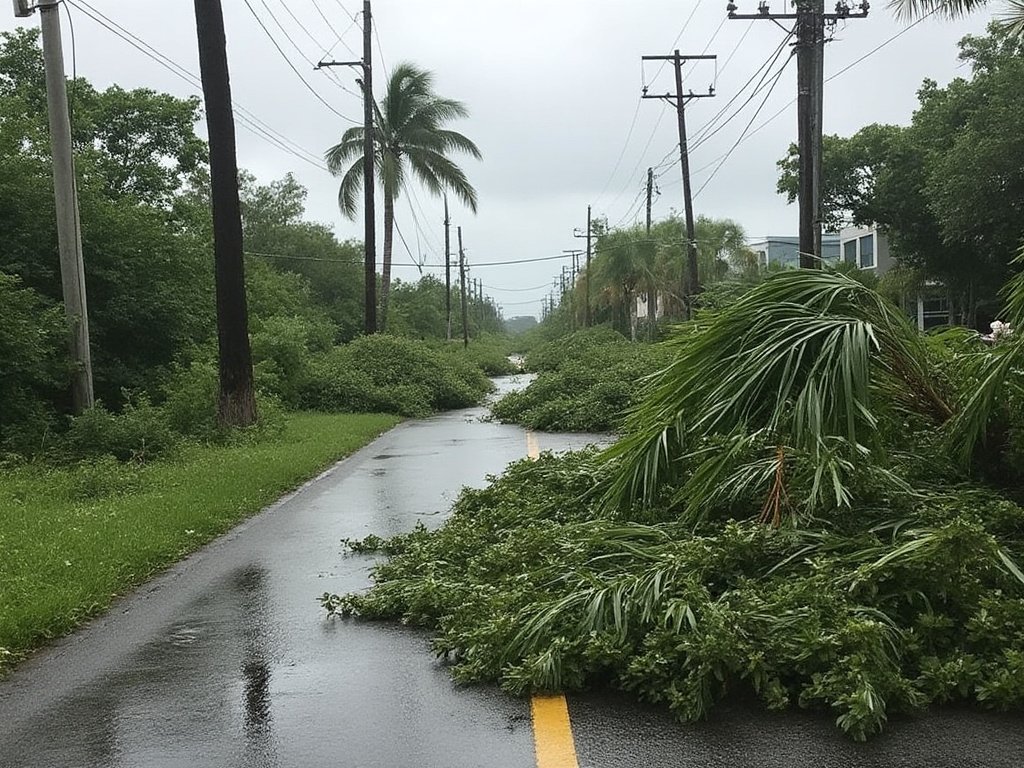The once vibrant streets of Miami are eerily quiet, save for the distant hum of generators and the occasional thrum of helicopters overhead. It’s been two days since Hurricane Helena made landfall, and while the storm has moved on, the damage left in its wake is all too present. As a journalist living in the heart of Miami, I have covered many storms, but none have impacted my city and state quite like Helena. The devastation stretches from the southernmost point of Key West to the northern reaches of Jacksonville, with almost no corner of Florida spared from its fury.
Hurricane Helena hit Florida as a Category 5 storm, bringing 165-mile-per-hour winds and an unimaginable storm surge. The storm’s relentless power overwhelmed coastal defenses, and floodwaters surged into neighborhoods, leaving behind a landscape of destruction. In just a few short hours, Helena changed the face of Florida. Yet, in the aftermath, it is the resilience of Floridians, the coordinated recovery efforts, and the community’s enduring spirit that shines through.
The Calm Before the Storm
In the days leading up to Hurricane Helena, Miami residents were eerily calm. Perhaps it was the “hurricane fatigue” that comes with living in a storm-prone area, or maybe it was a result of the numerous near-misses in the past decade. We’ve seen hurricanes intensify, then turn last-minute, leaving us with only a glancing blow. But this time, it was different.
On the Friday before the storm, meteorologists began warning that Helena would be nothing like we’d seen in recent years. What started as a Category 3 storm in the Caribbean strengthened rapidly, fueled by unusually warm waters in the Gulf of Mexico. Miami Mayor Francis Suarez urged residents to heed evacuation orders as early as possible, while grocery stores and gas stations experienced a familiar rush. Shelves were emptied, plywood was hauled by the truckload, and sandbags lined the doors of businesses.
While many evacuated, some Miamians chose to stay, bracing for the storm’s arrival. Local shelters opened their doors, and the Miami-Dade Emergency Operations Center became a hub of activity, coordinating everything from medical evacuations to distributing supplies. But as Saturday night approached, Helena’s winds howled louder, and the reality of what was coming began to set in.
The Arrival of Hurricane Helena
By early Sunday morning, Hurricane Helena was making its final approach toward the Florida Keys, where Key West was ground zero for its first landfall. The islands, connected by the famed Overseas Highway, experienced catastrophic winds and flooding. Despite mandatory evacuation orders, some locals decided to stay in their homes. The images from Key West were staggering: boats tossed onto highways, streets turned into rivers, and buildings shredded by the storm’s wrath.
From my apartment in downtown Miami, the winds started to pick up around midnight. By 3 a.m., the sky was alive with flashes of light—not from lightning, but from transformers exploding across the city. As I watched through a small crack in my hurricane shutters, debris flew past my windows. The gusts sounded like a freight train tearing through the streets, relentless in their intensity.
For hours, the storm battered Miami with unrelenting force. Water surged into Brickell, Miami’s financial district, turning the sleek, modern streets into a maze of submerged cars and debris. As the day wore on, the storm churned its way northward, leaving behind a swath of destruction in places like Fort Lauderdale and West Palm Beach.
Florida Wakes to Devastation
When the winds finally subsided on Monday morning, the city emerged into a changed world. Miami, a city known for its glitzy high-rises and sun-soaked beaches, looked like a war zone. Large palm trees, once the hallmark of the city’s tropical aesthetic, lay sprawled across streets, blocking intersections and crushing cars. Many buildings had lost their roofs or were heavily damaged by flying debris.
In the immediate aftermath, the power was out for nearly 90% of Miami-Dade County. Cell service was spotty at best, and people resorted to hand radios and word of mouth to communicate with loved ones. The airports were shut down, highways were flooded, and several key roadways leading into the city were impassable. The sense of isolation was palpable.
Despite this, there was an air of determination. Neighbors who barely knew each other before the storm came together to help clean up their blocks. Many Floridians, hardened by years of hurricane seasons, took immediate action to secure their homes, patch up damages, and prepare for what was expected to be a long recovery.
The Recovery Efforts Begin
By Tuesday morning, two days after Helena’s landfall, the magnitude of the recovery efforts had become clear. Federal aid, in the form of FEMA, was already being deployed to hard-hit areas like the Florida Keys and South Florida, while the National Guard had mobilized across the state to assist with rescues, clearing debris, and providing emergency relief.
In downtown Miami, emergency services worked around the clock to restore power and water. In Brickell, floodwaters had finally started to recede, revealing streets lined with abandoned cars, toppled trees, and broken glass from high-rise windows shattered by the intense winds.
Governor Ron DeSantis, who had preemptively declared a state of emergency days before the hurricane, took to the airwaves to address the situation. “We are facing one of the largest natural disasters in Florida’s history,” he said solemnly, “but we are resilient, and we will recover. Help is on the way.”
Convoys of utility trucks from states as far as Texas and North Carolina began streaming into Florida, tasked with the Herculean effort of restoring power. Residents who had evacuated slowly began returning to assess the damage. Yet, for many, there was nothing left to return to. In the Everglades and low-lying areas of Miami, entire neighborhoods had been flooded, and many homes were deemed uninhabitable.
While the devastation was far-reaching, efforts in Miami were better coordinated thanks to its extensive experience with storms. Emergency shelters were well-stocked, and local charities quickly mobilized to distribute food, water, and medical supplies to affected communities.
Key West: Ground Zero for Helena’s Fury
Key West, where Hurricane Helena made its first landfall, remains largely inaccessible two days after the storm. The Overseas Highway, the only route connecting the Florida Keys to the mainland, was severely damaged by the storm surge, with portions of it completely washed away. The Keys, a haven for tourists and retirees alike, were left isolated and crippled.
From reports filtering in through helicopter flyovers, it was clear that Key West bore the brunt of Helena’s wrath. Entire marinas were obliterated, with boats either sinking or being hurled onto land by the force of the storm. Iconic landmarks, like the Southernmost Point buoy, were reduced to rubble. The Monroe County Sheriff’s Office has confirmed that rescue and recovery teams are still working around the clock to reach those who were stranded, many of whom ignored evacuation orders.
“Helena hit us hard,” said one resident, speaking via satellite phone to a local Miami news station. “I’ve lived through Wilma, Irma, and so many others, but this one… this one is different. The damage is catastrophic.”
Search and rescue teams continue to comb through the wreckage, with the National Guard assisting in airlifting supplies and medical personnel to the islands. Given the extent of the damage, officials estimate it could be weeks before power is fully restored to the Keys, and months before any sense of normalcy returns.
Florida’s Strength in the Face of Adversity
As I continue to walk the streets of my neighborhood in Miami, I am struck by the dichotomy of destruction and hope. On one corner, a luxury condo stands with shattered windows and water-streaked walls. On the other, a group of neighbors has banded together, offering food and water to those in need. It is this spirit of resilience that defines Floridians—a people hardened by hardship, but always willing to lend a helping hand.
Hurricane Helena, with all its fury, has brought Florida to its knees. Yet, just two days after the storm, the recovery is well underway. The power outages, flooded streets, and damaged homes are daunting, but they are not insurmountable.
Across the state, donations are pouring in from across the country. Volunteers are arriving in droves to help clean up debris, distribute supplies, and offer support to those who have lost everything. Florida’s major cities, like Miami and Tampa, have rallied together to send aid to the hardest-hit areas, demonstrating that in times of crisis, community and compassion triumph over despair.
Looking Ahead: The Long Road to Recovery
Despite the rapid response, the road to recovery will be long and arduous. Hurricane Helena has left behind billions of dollars in damage, and the emotional toll on Florida’s residents is immeasurable. Many families have lost their homes, livelihoods, and, in some tragic cases, loved ones. Schools have been closed indefinitely, businesses have been decimated, and thousands remain displaced.
Yet, if there is one thing we have learned from past hurricanes, it is that Florida will recover. It may take months, or even years, to fully rebuild, but the state’s infrastructure and emergency response systems have never been better equipped. Local leaders, alongside federal agencies, are already working on plans for long-term rebuilding efforts, including making coastal areas more resilient to future storms.
As I sit here, penning this story, I am reminded of a conversation I had with a local Miami resident just this morning. “We’ve been through this before,” she said with a tired but hopeful smile. “We rebuild. We move on. And we come back stronger.”
Her words, like the many acts of kindness I’ve witnessed in the last 48 hours, remind me that while hurricanes may knock us down, they never knock us out. Florida will rise again—stronger, more united, and more prepared for whatever the future may hold.
FAQs
What caused Hurricane Helena to be so powerful? Hurricane Helena intensified rapidly due to the unusually warm waters in the Gulf of Mexico, reaching Category 5 status before making landfall in Florida.
How does the recovery process work after a hurricane? Recovery typically begins with search and rescue efforts, followed by restoring essential services like power and water. Then, teams work on clearing debris and rebuilding infrastructure.
What areas of Florida were hardest hit by Hurricane Helena? The Florida Keys, particularly Key West, and parts of South Florida, including Miami and Fort Lauderdale, experienced some of the worst damage.
How long will it take for Florida to fully recover? While initial recovery efforts can take weeks, the full rebuilding process, especially in heavily damaged areas like the Florida Keys, could take months or even years.
How can I help with the recovery from Hurricane Helena? Donating to reputable disaster relief organizations, volunteering with cleanup efforts, and providing supplies to local charities are all ways to contribute.
Was Miami prepared for Hurricane Helena? While Miami has extensive hurricane preparedness protocols, the sheer strength of Helena caught many by surprise, leading to significant damage in some areas. However, recovery efforts were swift and well-coordinated.





